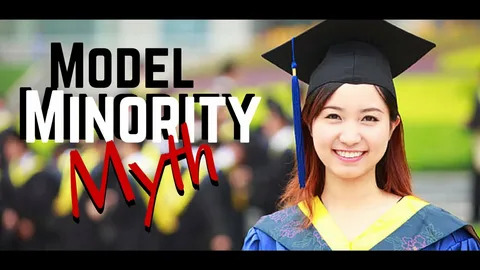The “model minority” myth is a stereotype that paints Asian Americans and some other minority groups as universally successful, intelligent, hardworking, and compliant. At first glance, it may seem like a positive generalization. But dig deeper, and you’ll see that this stereotype causes real damage—both to individuals and communities.
This blog explores the origins, consequences, and dangers of the model minority myth, while also highlighting how educational platforms like Our E-Class can play a crucial role in reshaping narratives and supporting all students equitably.
Where Does the Model Minority Myth Come From?
The model minority myth took shape during the civil rights era of the 1960s in the United States. At the time, Asian Americans—especially those who came through selective immigration policies favoring skilled professionals—were portrayed in the media as hard-working, family-oriented, and academically gifted. The intent was often political: to contrast Asian Americans with other minority groups, suggesting that the “right attitude” could overcome discrimination and disadvantage.
But this “success story” ignores the diversity and struggles within the Asian American community. Many subgroups, such as Hmong, Cambodian, Laotian, and Burmese populations, face severe economic hardship and limited access to quality education, yet these challenges are often hidden behind a misleading narrative of universal success.
How the Model Minority Myth Harms People
Despite its surface-level positivity, the model minority stereotype imposes harmful pressures and creates unfair expectations. Here’s how:
1. Unrealistic Pressure to Succeed
The myth sets incredibly high standards, particularly in academics and career choices. Asian American students are often expected to excel in math and science, attend top universities, and pursue careers in medicine, law, or engineering. Those who don’t follow this path may feel like failures—not because of personal shortcomings, but because of society’s imposed standards.
This pressure can lead to anxiety, depression, and burnout. Research from the National Alliance on Mental Illness (NAMI) shows that only 8.6% of Asian Americans seek mental health support, compared to nearly 20% of White Americans. Cultural stigma and expectations often keep individuals from reaching out for help.
2. Ignoring Intra-Community Diversity
The myth erases the wide range of experiences within minority groups. Asian Americans are not a monolith—they hail from over 20 countries, speak various languages, and represent diverse socioeconomic backgrounds. For instance:
- Nearly 25% of Hmong Americans live in poverty.
- Burmese and Cambodian Americans also report high poverty rates.
- The income gap among Asian Americans is the widest of any racial group in the U.S., according to Pew Research Center.
This stereotype disregards these disparities and instead promotes a one-size-fits-all narrative that benefits only the most privileged subgroups.
3. Damaging Interracial Solidarity
The model minority myth isn’t just harmful to Asian Americans. It has been used to pit minority groups against each other. By holding up one group as an example, it subtly (or sometimes directly) implies that others are underperforming due to lack of effort. This false narrative undermines the systemic inequalities faced by other communities, particularly Black and Hispanic populations.
The myth perpetuates the idea that racism can be “overcome” simply through hard work, thereby ignoring the ongoing impact of structural discrimination.
4. Mental Health Toll
The constant need to live up to an ideal image takes a serious toll on mental well-being. Students and professionals may internalize the pressure, leading to stress, anxiety, and isolation. They may also be less likely to seek counseling or mental health services, often due to cultural stigma and fear of appearing weak.
In educational and workplace settings, these individuals may be less likely to ask for help—even when they desperately need it.
Debunking the Model Minority Myth with Data
Let’s look at some real statistics that reveal the truth behind the stereotype:
- Income Inequality: According to Pew Research, the top 10% of Asian American earners make more than 10 times what the bottom 10% earn.
- Poverty Rates: The U.S. Census Bureau reports that 12% of Asian Americans live in poverty—higher than the poverty rate for white Americans.
- Mental Health Access: Only 6% of Asian Americans seek professional mental health help, even as many silently suffer under pressure.
These figures challenge the notion that Asian Americans universally “succeed” and instead show that like any group, they face unique, complex challenges.
The Role of Education and Tools Like Our E-Class in Breaking the Myth
To combat the harmful impact of the model minority myth, we need systemic change—starting with education. Schools can become agents of change by promoting inclusivity, fostering open conversations, and addressing the real needs of all students.
One way to do this is by using classroom management platforms like Our E-Class.
Empowering Equitable Learning with Our E-Class
Our E-Class provides academic management solutions for schools and educational facilities that streamline administrative tasks while enhancing communication and access to resources. Here’s how it supports fair and inclusive education:
- Timetable & Attendance Automation: Minimizes manual errors and frees up time for teachers to focus on student engagement.
- Performance Tracking & Behavior Monitoring: Allows educators to track each student’s academic journey holistically, identifying those who might be struggling beneath the surface of stereotypes.
- Mental Health & Well-being Integration: By fostering better communication between educators, students, and parents, Our E-Class helps create a safe environment where students feel supported.
- Parent Engagement Tools: Keeps parents informed about their child’s progress in real-time, encouraging early intervention if a student is underperforming—not just academically but emotionally or behaviorally.
- Access to Digital Resources: Ensures that students from all backgrounds can access study materials and learning tools anytime, anywhere, leveling the playing field.
- Virtual Classrooms and Real-Time Messaging: Encourages collaborative learning and open discussions about diversity, stereotypes, and cultural inclusion.
By implementing tools like Our E-Class, schools can dismantle myths and ensure every student is seen, heard, and supported.
Moving Beyond the Myth
The model minority myth is more than a stereotype—it’s a barrier that prevents many from living authentically and receiving the support they need. It glosses over real issues, breeds resentment among racial groups, and upholds unrealistic standards.
To move forward, we must:
- Recognize diversity within every community.
- Challenge stereotypes whenever we see them.
- Support mental health and open conversation in educational settings.
- Use smart tools like Our E-Class to track individual needs and promote equity.
Final Thoughts
The model minority myth might appear flattering, but it’s deeply harmful. It distorts reality, fosters division, and imposes intense pressure on individuals to meet unfair expectations. Only by acknowledging its dangers and taking intentional steps—like integrating inclusive educational tools such as Our E-Class—can we begin to support all students fairly and fully.
Let’s shift the narrative. Not all success looks the same, and every student deserves the opportunity to define it on their own terms.









